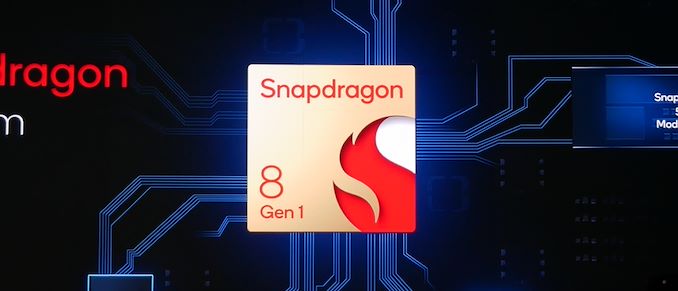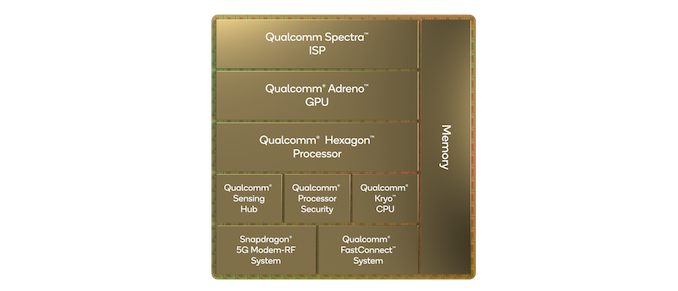The Snapdragon 8 Gen 1 Performance Preview: Sizing Up Cortex-X2
by Dr. Ian Cutress on December 14, 2021 8:00 AM EST
At the recent Qualcomm Snapdragon Tech Summit, the company announced its new flagship smartphone processor, the Snapdragon 8 Gen 1. Replacing the Snapdragon 888, this new chip is set to be in a number of high performance flagship smartphones in 2022. The new chip is Qualcomm’s first to use Arm v9 CPU cores as well as Samsung’s 4nm process node technology. In advance of devices coming in Q1, we attended a benchmarking session using Qualcomm’s reference design, and had a couple of hours to run tests focused on the new performance core, based on Arm’s Cortex-X2 core IP.
The Snapdragon 8 Gen 1
Rather than continue with the 800 naming scheme, Qualcomm is renaming its smartphone processor portfolio to make it easier to understand / market to consumers. The Snapdragon 8 Gen 1 (hereafter referred to as S8g1 or 8g1) will be the headliner for the portfolio, and we expect Qualcomm to announce other processors in the family as we move into 2022. The S8g1 uses the latest range of Arm core IP, along with updated Adreno, Hexagon, and connectivity IP including an integrated X65 modem capable of both mmWave and Sub 6 GHz for a worldwide solution in a single chip.
While Qualcomm hasn’t given any additional insight into the Adreno / graphics part of the hardware, not even giving us a 3-digit identifier, we have been told that it is a new ground up design. Qualcomm has also told us that the new GPU family is designed to look very similar to previous Adreno GPU sfrom a feature/API standpoint, which means that for existing games and other apps, it should allow a smooth transition with better performance. We had time to run a few traditional gaming tests in this piece.
On the DSP side, Qualcomm’s headlines are that the chip can process 3.2 Gigapixels/sec for the cameras with an 18-bit pipeline, suitable for a single 200MP camera, 64MP burst capture, or 8K HDR video. The encode/decode engines allow for 8K30 or 4K120 10-bit H.265 encode, as well as 720p960 infinite recording. There is no AV1 decode engine in this chip, with Qualcomm’s VPs stating that the timing for their IP block did not synchronize with this chip.
AI inference performance has also quadrupled - 2x from architecture updates and 2x from software. We have a couple of AI tests in this piece.
As usual with these benchmarking sessions, we’re very interested in what the CPU part of the chip can do. The new S8g1 from Qualcomm features a 1+3+4 configuration, similar to the Snapdragon S888, but using Arm’s newest v9 architecture cores.
- The single big core is a Cortex-X2, running at 3.0 GHz with 1 MiB of private L2 cache.
- The middle cores are Cortex-A710, running at 2.5 GHz with 512 KiB of private L2 cache.
- The four efficiency cores are Cortex-A510, running at 1.8 GHz and an unknown amount of L2 cache. These four cores are arranged in pairs, with L2 cache being private to a pair.
- On the top of these cores is an additional 6 MiB of shared L3 cache and 4 MiB of system level cache at the memory controller, which is a 64-bit LPDDR5-3200 interface for 51.2 GB/s theoretical peak bandwidth.
Compared to the Snapdragon S888, the X2 is clocked higher than the X1 by around 5% and has additional architectural improvements on top of that. Qualcomm is claiming +20% performance or +30% power efficiency for the new X2 core over X1, and on that last point it is beyond the +16% power efficiency quoted by Samsung moving from 5nm to 4nm, so there are additional efficiencies Qualcomm is implementing in silicon to get that number. Unfortunately Qualcomm would not go into detail what those are, nor provide details about how the voltage rails are separated, if this is the same as S888 or different – Arm has stated that the X2 core could offer reduced power than the X1, and if the X2 is on its own voltage rail that could provide support for Qualcomm’s claims.
The middle A710 cores are also Arm v9, with an 80 MHz bump over the previous generation likely provided by process node improvements. The smaller A510 efficiency cores are built as two complexes each of two cores, with a shared L2 cache in each complex. This layout is meant to provide better area efficiency, although Qualcomm did not explain how much L2 cache is in each complex – normally they do, but for whatever reason in this generation it wasn’t detailed. We didn’t probe the number in our testing here due to limited time, but no doubt when devices come to market we’ll find out.
On top of the cores is a 6 MiB L3 cache as part of the DSU, and a 4 MiB system cache with the memory controllers. Like last year, the cores do not have direct access to this 4 MiB cache. We’ve seen Qualcomm’s main high-end competitor for next year, MediaTek, showcase that L3+system cache will be 14 MiB, with cores having access to all, so it will be interesting to see how the two compare when we have the MTK chip to test.
Benchmarking Session: How It Works
For our benchmarking session, we were given a ‘Qualcomm Reference Device’ (QRD) – this is what Qualcomm builds to show a representation of how a flagship featuring the processor might look. It looks very similar to modern smartphones, with the goal to mirror something that might come to market in both software and hardware. The software part is important, as the partner devices are likely a couple of months from launch, and so we recognize that not everything is final here. These devices also tend to be thermally similar to a future retail example, and it’s pretty obvious if there was something odd in the thermals as we test.
These benchmark sessions usually involve 20-40 press, each with a device, for 2-4 hours as needed. Qualcomm preloads the device with a number of common benchmarking applications, as well as a data sheet of the results they should expect. Any member of the press that wants to sideload any new applications has to at least ask one of the reps or engineers in the room. In our traditional workflow, we sideload power monitoring tools and SPEC2017, along with our other microarchitecture tests. Qualcomm never has any issue with us using these.
As with previous QRD testing, there are two performance presets on the device – a baseline preset expected to showcase normal operation, and a high performance preset that opportunistically puts threads onto the X2 core even when power and thermals is quite high, giving the best score regardless. The debate in smartphone benchmarking of initial runs vs. sustained performance is a long one that we won’t go into here (most noticeably because 4 hours is too short to do any extensive sustained testing) however the performance mode is meant to enable a ‘first run’ score every time.














169 Comments
View All Comments
StevoLincolnite - Wednesday, December 15, 2021 - link
We have reached a point where even a low-range phone is "good enough" for 90% of users out there... Usually the draw backs of those devices tend to be in the display (LCD) or camera sensors rather than how snappy the device is.Today I walked into a store to see what I could upgrade my Samsung Galaxy Note 20 Ultra 5G to.. It's been 18 months and from a camera and display perspective, nothing was really worth dropping another $2,000 AUD on... Because I am not going to perceive any difference in device snappiness... Even though I keep it in power saving mode 24/7 for increased battery life anyway.
TheinsanegamerN - Friday, December 17, 2021 - link
Moto g power 2020, has a snapdragon 665, 1080p display, and stereo speakers alongside a huge battery for $229. With phones like that, I have no idea why people were buying $1400+ flagships.Of course now manufacturers are cheaping out, using 720p displays and mediatek chips to push you towards their $500-600 mid range ptions.
Bd0N - Wednesday, December 15, 2021 - link
Here’s where having a processor that’s more than “fast enough” matters. Software grows in complexity over time and Apple’s devices get updates for 6-8 years. What may seem like unnecessary performance now ensures that devices feel snappy throughout their lifetime. Your S865 would be struggling to support software that much younger than it. But of course you don’t get updates for that long and that’s why iPhones have a higher resell value.nucc1 - Thursday, December 16, 2021 - link
I can buy another mid range android every 24 months to keep up with software bloat and still come out ahead in dollar terms vs iPhone :)TheinsanegamerN - Friday, December 17, 2021 - link
Android phones dont need updates to continue getting new software. You can buy an android phone running android 6 and still play all the latest games and apps.Iphones, OTOH, are screwed once updates stop for 1-2 years. Effectively both brands have the same lifespan, the difference being iphones are cut off by apple instead of developers.
iphonebestgamephone - Friday, December 17, 2021 - link
Wrong. Both the citra 3ds emulator and aethersx2 ps2 emulator need android 8 and 7 respectively. Genshin impact and dead by daylight need 7. There's prolly a lot more.Reflex - Monday, December 20, 2021 - link
This is factually incorrect, Google is fairly aggressively cutting off support for older versions of Android for app developers, and they are right to do so for security reasons. What they have not done is meaningfully extended the support lifecycle for hardware, so you get the worst of both worlds: Short support lifecycle and hardware that is decreasingly useful due to the app library thinning with every app update.Nicon0s - Saturday, December 18, 2021 - link
"Here’s where having a processor that’s more than “fast enough” matters. Software grows in complexity over time and Apple’s devices get updates for 6-8 years. What may seem like unnecessary performance now ensures that devices feel snappy throughout their lifetime. Your S865 would be struggling to support software that much younger than it."I wound wager that "his 865" will do just as fine long term as the A13, the generational equivalent from Apple. The CPU is no the only relevant component for performance when looking at a phone. Other component like RAM, Storage and Wireless connection efficiency and performance are also very very important. The A13 isn't even faster in multi-core which is just becoming more and more important as times goes by and especially with Android which a more multi-core oriented system than iOS.
Kangal - Sunday, December 19, 2021 - link
That's true.However, an iPhone will still age better than any Android device. That's the perks of having vertical integration. You'll have more optimised hardware, more optimised software, and more optimised third-party support.
For instance:
iPhone 5S (A7) vs (QSD 800) Samsung Note 3
iPhone 6S+ (A9) vs (QSD 810) Sony Z5 Premium
iPhone 8+ (A11) vs (QSD 835) Google Pixel 2XL
iPhone 11 Max (A13) vs (QSD 855) ASUS RoG 2
And these are what I thought were strong competitors. For general use stuff, Apple wins. While it has some obvious drawbacks. And I can admit this as an Android user, credit where it's due.
Nicon0s - Saturday, December 25, 2021 - link
"You'll have more optimised hardware, more optimised software, and more optimised third-party support."I keep hearing this but it's not like hardware and software is only integrated and optimized on Apple devices.
"And these are what I thought were strong competitors."
I don't think those "were strong competitors", you just picked a few random phones and compared them.
Like I've said the CPU is not the only relevant component. The SD 865 has a stronger GPU in sustained performance and much better connection performance. Also most SD 865 phones have 8GB of RAM. So in the long run it won't fare worse than iphones with the A13 as it's not a less capable and less efficient SOC it only scores lower in CPU benchmarks.